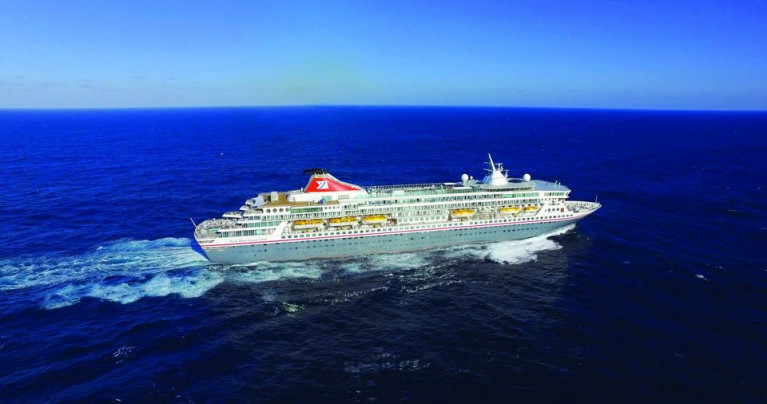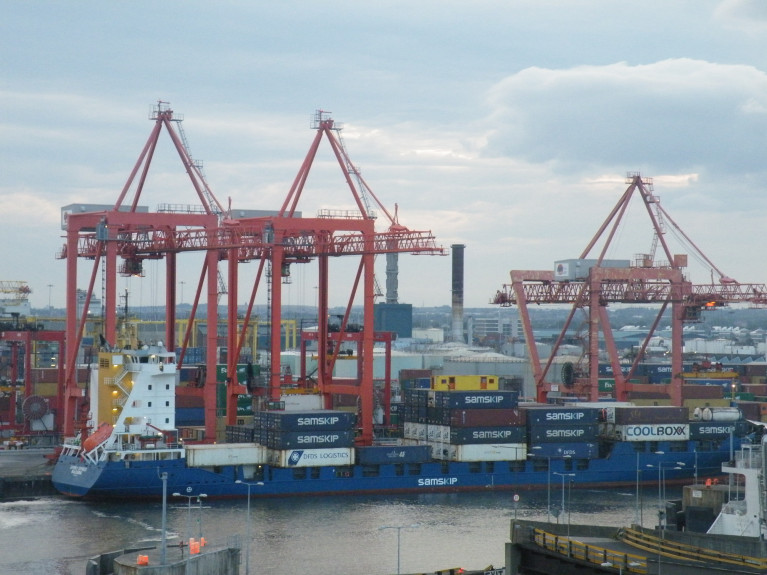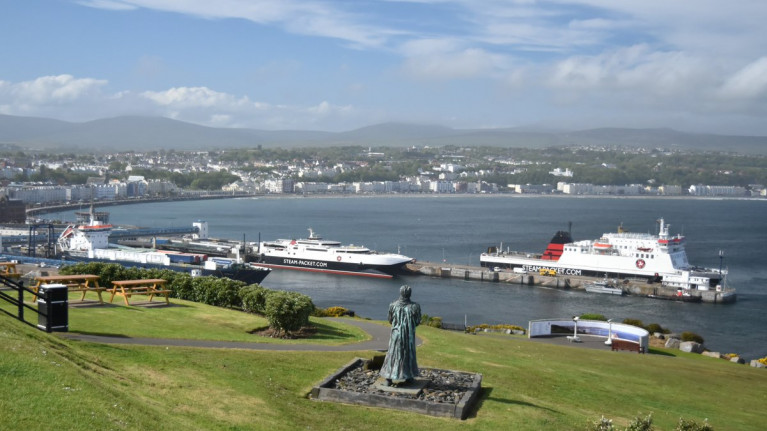Displaying items by tag: A&P Falmouth
Dublin Swift Heads for West Country Prior to Wales Route Resumption While Stena Europe Awaits Falmouth for Orders?
Less than a week ago, Afloat tracked Irish Ferries Dublin Swift at Cardiff, however the fast ferry has since sailed from Wales to England, for dry-docking in advance of resuming seasonal service to Holyhead next month, writes Jehan Ashmore.
The Cypriot flagged Dublin Swift went to A&P Falmouth, where Afloat also tracked the recently replaced Rosslare-Fishguard ferry, Stena Europe, following the return of Stena Nordica to service upon completion of works to a berth linkspan at the south Wales port. This finally released the ‘Europe’ to head for Falmouth and receive a dry-docking, which has also taken place with the 1982 built ferry currently remaining in the Cornish port alongside a layover quay.
When Stena Europe made an unexpected return to the Ireland-Wales in January, the ageing ferry had been on charter across the Strait of Gibraltar, linking Spain and Morocco. So after a stint spent on the Europe-Africa route, it was a surprise to see the return of the veteran vessel in its 42 year make its presense to its old homeport of Fishguard after seemingly leaving for the final time in July last year.
It was during a personal ‘farewell’ crossing made last month, that it was observed that the long-serving St. Georges Channel ferry of 21 years, had been re-registered (likewise of Dublin Swift) to Limassol, Cyprus, with the ferry now part of Stena Line Pte Ltd of Singapore, Asia.
For ferry fans and Welsh locals of the Fishguard favourite, the ferry no longer has its homeport of registry, and the ‘Red Duster’ is also absent from the stern flagpole. So what winds will next blow for the ferry and in what direction?
Afloat still awaits a response from Stena as to the future of the ferry which, until last year, had boosted the largest passenger capacity on their Irish Sea network, with an impressive 2,076 passengers in total. However, that accolade ceased on the last day of June with the introduction of the Rosslare-Cherbourg route’s larger of two ferries, Stena Vision, with 2,400 guests.
Now again, the Stena Vision regains this status as one of the largest in the overall Stena Line fleet, which includes those serving in the North Sea, throughout the Nordic nations, and on the Baltic Sea.
A&P Falmouth Completes Refurbishment of Largest Passenger Ship to Facility in More than 60 Years
The dockyard of A&P Falmouth in south-west England has completed a multi-million-pound programme of works on the largest passenger ship to visit the facility in over 60 years.
Fred. Olsen Cruise Lines’ flagship MV Bolette which carries up to 1,338 passengers and 645 crew had entered the dry dock in Cornwall on 23 February and was completed on Tuesday of last week.
The 13-day refurbishment included maintenance to the cruiseship’s azipods and bow thrusters as well a new application of underwater paint.
Over 500 members of the A&P workforce and supply chain have been working around the clock to support this contract from Fred. Olsen Cruise Lines which is based in Ipswich, Suffolk. The cruise operator, which is part of the Norwegian Olsen group, offers regional cruises departing from Dover, Southampton, Liverpool, Newcastle and Rosyth (Edinburgh).
During the dry-docking of Bolette, the workforce included 32 apprentices that have had the experience to work on board the former Amsterdam, Afloat adds, of original operator Holland America Line (HAL) which along with sister Rotterdam has called to Irish ports.
Both mid-sized cruiseships (approx.62,000 gross tonnage) were acquired by Fred. Olsen during the fallout of the first year of Covid19 that severely impacted the global cruise industry.
This is the second time in 12 months that Fred. Olsen has chosen to dock at A&P Falmouth, with their third ship Balmoral completing a programme of work in May last year. On that occasion work included steel inserts, ship side valves, tunnel thruster overhaul and underwater paint.
Mike Spicer, Managing Director of A&P Falmouth said: “A&P was delighted to welcome Bolette to the facility".
David McGinley, CEO said; “It is fantastic to welcome Fred. Olsen's Bolette into A&P Falmouth. Projects such as these help us to sustain our workforce, apprenticeship programme and supply chain which drives prosperity and adds real social value to the South West of England".
“We are delighted to continue our partnership with Fred. Olsen Cruise Lines, welcoming their cruise ships for dry dockings across our Group.”
Fred. Olsen Cruise Lines has returned to Newcastle but for the first time with the newly refurbished Bolette, which embarked on its inaugural season based from the North Sea port.
The passengers on board the flagship's current cruise from Newcastle is titled ‘In Search of the Northern Lights in Nine Nights’.
The milestone for Fred. Olsen was marked with a plaque exchange from the Port of Tyne to Captain Mikael Degerlund prior to Bolette setting sail.
Afloat adds the cruiseship was tracked this morning (13th March) to the port of Tromso, Norway.
A dry-dock at A&P Falmouth has welcomed a 218-meter /1,325 capacity cruise ship which is operated by Fred. Olsen Cruise Lines.
Fred. Olsen cruise ships are regular visitors to Falmouth International Cruise Terminal, which is also operated by A&P. However, this is the first time the company has chosen to send its cruise ships to A&P for ship repair works.
The Balmoral’s programme of works includes steel inserts, ship side valves, tunnel thruster overhaul and underwater paint.
Eddie Purves, Group Managing Director at A&P Group said: “We are delighted that Fred. Olsen Cruise Lines has chosen to take advantage of A&P Group’s ship repair facilities.”
“A&P Group is the UK”s largest commercial ship repair operation. The combination of our three strategic locations, seven dry docks, fabrication services and wide-reaching skills and capabilities makes our facilities a first-class choice for cruise customers who operate in the UK and beyond.”
“A&P Falmouth is strategically located next to the English Channel and offers full drydocking facilities to medium size cruise ships with excellent on site machining capabilities.
“Falmouth’s International Cruise Terminal is a firm favourite with some of the world’s leading cruise companies, with vessels visiting the port for transit and turnaround calls.
“Our ambition is now to make A&P Falmouth and A&P Tyne a centre of excellence in cruise ship repair, minimising the downtime of customers vessels and enhancing the availability of their fleet.”
David McGinley, CEO said; “It has been fantastic to welcome Fred. Olsen's Balmoral into A&P Falmouth.”
“Contracts such as these help us to sustain our workforce, apprenticeship programme and supply chain which drives prosperity and adds real social value to the South West of England and beyond.
“We are delighted to welcome the MV Balmoral to Falmouth and look forward to developing our partnership with Fred. Olsen.”
Peter Deer, Managing Director at Fred. Olsen Cruise Lines, said: “Our smaller ships regularly call into Falmouth as part of our UK sailings, and it’s a town that we know our guests love to visit with us. “We are really pleased to be expanding this relationship with A&P Falmouth by working with them for a dry dock for our elegant Balmoral, as we get her ready for a return to service with us in early May.
“As a family-run cruise line, we know how important it is to support local communities. By docking in Falmouth, we are pleased to be supporting the local community here and the wider supply chain as Balmoral prepares to welcome her first guests back on board.
“We look forward to an even stronger working relationship with A&P Group both now and in the future.”
A&P Falmouth Reports Six Months of 100% Occupancy
The largest shipyard-repair complex in the UK, A&P Falmouth, announced that they had a 100% occupancy of all three dry docks over the last six months - with some docks occupied simultaneously by multiple vessels.
A&P Falmouth carried out repairs and maintenance on more than 40 commercial vessels and nine defence vessels between September 2020 and February 2021 which, according to Business Development Director Andrea Sabbion, is ‘testament to the flexibility of A&P’s workforce, collaborative relationships and project planning expertise.’
Vessels included those covered by A&P Falmouth’s commercial partnership agreements with ferry operator, Red Funnel and their (Red Eagle, Red Falcon and Red Osprey) and Condor Ferries (for Commodore Goodwill, Condor Liberation and Condor Rapide). In addition to a number of offshore units, dredger and tug boats from top UK clients.
Significant projects have also been delivered for new clients – including returning offshore supply ship Pacific Constructor to its original condition with a number of precise demobilisation activities, removals and repairs.
As well as delivering a comprehensive programme of major steel repairs for the German containership Samskip Express, owned by Köpping Reederei. This project of the containership was required following a grounding on the Irish coast (last year) and involved a 76 day stay at A&P Falmouth while extensive repairs were made to the shell plating and ballast pipework, which used more than 60 tonnes of steel.
A&P Falmouth has also continued its delivery of its ten year In-Service Support contract with the Ministry of Defence to provide global maintenance support to the Bay Class vessels and ocean survey vessel HMS Scott - with RFA Argus arriving in Falmouth earlier this year to undergo a comprehensive docking period.
Other vessels to dock at A&P Falmouth during this period included ro-ro cargo ship Opaline which is managed technically by AW Shipmanagement and owned by CLdN, Isle of Man Steam Packet Company’s Ben My Chree (see newbuild story), WightLink Ferries’ St. Faith and St. Clare. Also Aggregate Industries’ hopper dredger AI Avocet, Tarmac’s City of Cardiff and City of Chichester, aircrew training workboat Smit Yare and Svitzer UK’s tug Svitzer Harty.
Andrea Sabbion, Business Development Director at A&P Falmouth said: “The success of the last six months is an exceptional result for Falmouth, particularly in the face of the widespread challenges of the pandemic and the uncertainty created by Brexit.
“The fact that some of our docks have been occupied by more than one vessel at a time really highlights demand and the importance and value of our highly-skilled project planning and scheduling teams. In response, we are actively encouraging clients to discuss their requirements with us at the earliest opportunity.
“Looking ahead we plan to maintain the balance we’ve struck between emergency and scheduled repairs and new and existing clients – as this allows us to expand our reach and mitigate risk. We expect our berths, docks and resources to be in continual use throughout the Summer – particularly as we look to explore opportunities in different segments and different markets such as Norway, Germany and Holland.”
Speaking about the pandemic, Andrea added: “We know the challenges of the pandemic aren’t yet over, but we are confident the strict Covid-19 HSEQ measure we put in place last year will continue to serve us well.”
A&P Falmouth is part of A&P Group - a leading provider of ship repair, conversion and marine services and heavy engineering expertise which operates seven dry docks and extensive fabrication facilities across three strategic locations in the UK.
As one of the leading engineering business in the UK, A&P is involved in a diverse range of fabrication and repair projects across a broad cross section of sectors including Defence, Marine, Oil and Gas, Subsea, Energy, Civil and Nuclear.
High profile projects have included delivering block build fabrication for the Astute Submarine Class, HMS Queen Elizabeth Aircraft Carriers and RRS Sir David Attenborough, as well as fabricating pontoons and sea fastenings for the offshore wind sector.
All A&P Group facilities combine a rich heritage of marine and engineering skills and experience, providing a diverse customer base with all the precision skills needed to complete the most demanding projects.
Manx Ferry Ben-My-Chree Requires Repairs for 'At Least a Week'
A Manx ferry Ben-my-Chree will be out of action for 'at least a week' as it undergoes repair work to one of its propellers.
The Isle of Man Steam Packet Company says it sustained damage when entering Heysham harbour, and it'll go into dry dock on Tuesday.
After inspection by divers, as well as investigations by the manufacturers of the propeller control systems, it's been decided the repairs can't be carried out whilst the vessel is afloat.
Manx Radio understands the Ben-my-Chree only returned to Douglas at around 12:30 this morning.
It'll sail from Douglas to Falmouth dry dock on Tuesday, with a further inspection and assessment by specialists to take place there.
The ropax built in 1998 Afloat adds having sailed overnight from the Irish Sea is currently off the Cornish coast while at Falmouth anchorage.
French Routes Cruiseferry Undergoes Overhaul In UK Yard
#DryDocking - Ireland-France cruiseferry, Oscar Wilde will resume seasonal services next month but in the meantime the ship is undergoing routine maintenance in a UK shipyard, writes Jehan Ashmore.
According to a source following a visit to Falmouth, Cornwall the Irish Ferries Rosslare routes cruiseferry was seen in dry-dock with a damaged tail ramp having carried out routine tests.
The 1400 passenger / 580 car Oscar Wilde was introduced by Irish Ferries almost a decade ago when making a debut on the Rosslare-Cherbourg route in late 2007.
The 31,000 gross tonnage ship offered superior standards with luxurious facilities compared to the 1982 built Normandy in which she replaced from the continental link. The one-time former Stena Normandy, also served that owner out of Southampton to the same French port as part of long and varied career until scrapping. An elder sister, Stena Europe remains serving Rosslare-Fishguard.
Oscar Wilde was originally named as Kronprins Harald having been launched in 1987 at the Oy Wärtsilä AB shipyard, Turku, Finland for Norwegian owners, Jahre Line. The Scandinavian cruiseferry began her career serving the Oslo-Kiel service. This route is two hours longer than that of the 17 hours 30 minutes crossing time on the Irish route to Cherbourg.
In 1991 the impressive cruiseferry was sold to fellow Norwegian operators, Color Line. She served under the same name until sale to current owners, Irish Continental Group.
ICG’s ferry division will see Oscar Wilde return to Rosslare duties by beginning sailings on 1 March. The route to Normandy will be complimented in the high-season with the service to Roscoff, Brittany that begins in May.
Ferry For Falmouth
#FERRY NEWS – European Endeavour (2000/ 24,046grt), the largest of three ferries running for P&O's Dublin-Liverpool route departed from the capital's port this afternoon bound for A&P Groups dry-dock facility in Falmouth, writes Jehan Ashmore.
The former Dover-Calais serving ferry started working on the Irish Sea on a full-time basis last year as previously reported. Her fleetmates are the 17,000 tonnes sisters Norbank and Norbay.
The trio of ro-pax ferries are to a design where freight is predominately the main cargo and passenger capacity is reduced considerably compared to most conventional ferries. European Endeavour can handle 130 lorries and accommodate 210 passengers whereas her fleetmates are the reverse with greater freight capacity for 150 freight units and a reduced capacity for 114 passengers.
P&O are the only ferry firm on the route providing passenger and car ferry service though they do not cater for 'foot' passengers. Their rivals Seatruck Ferries offer the only dedicated freight-operation on a network of routes on the north Irish Sea including the Liffey-Mersey link, where in recent months new tonnage has entered service.
Stena's Southern Sailings
In the meantime freight-only ferry Stena Seafarer is operating the St. Georges Channel route having arrived at Rosslare on a repositioning voyage from Belfast on 29th March.
Stena Seafarer (1975 / 10,957grt) was one of a trio of freight-ferry sisters that served the Larne-Fleetwood port route until its closure in December. Like her sisters Stena Leader (1975 / 12,879grt) and Stena Pioneer (1975 / 14,426grt) they were built at the West German shipyard of J.J. Sietas in Hamburg.
Stena Seafarer's sisters remain laid-up in Belfast and with each vessel over 35 years in service it would seem likely there are nearing the end of their careers, at least on the Irish Sea.
To provide additional passenger capacity the Stena 'Express' fast-ferry service will return to the southern corridor route between 1 July-4 September. The high-season sailings as usual will be operated by the InCat built Stena Lynx III which is to operate a daily single round trip in tandem with Stena Europe.




























































